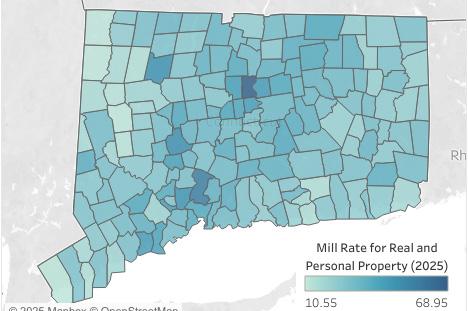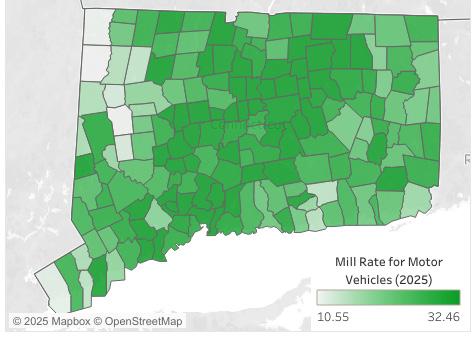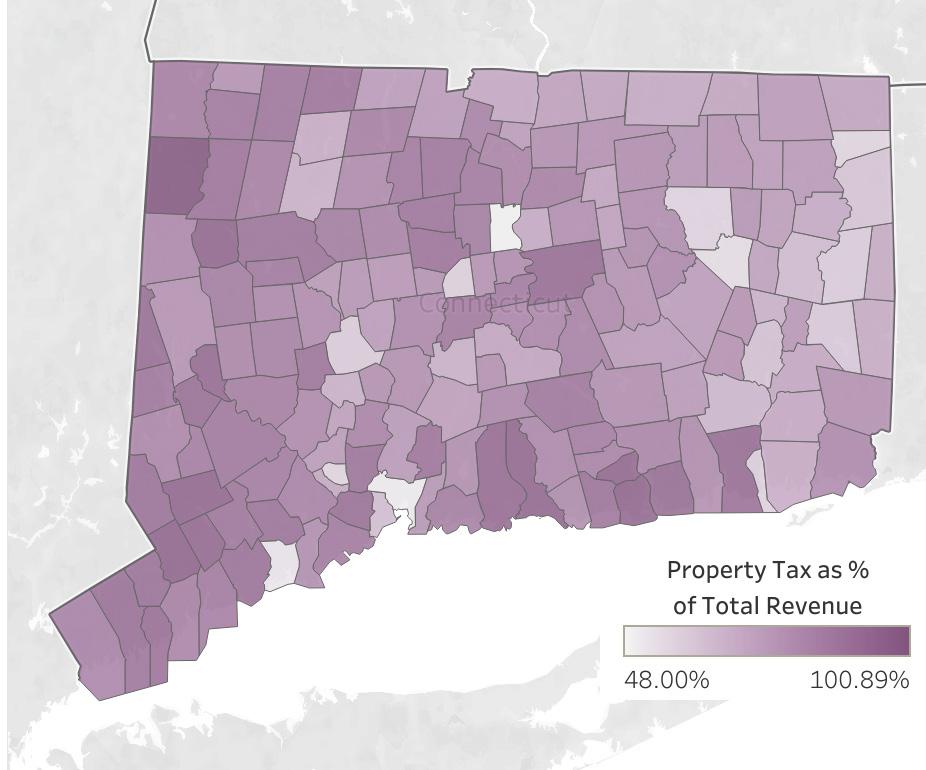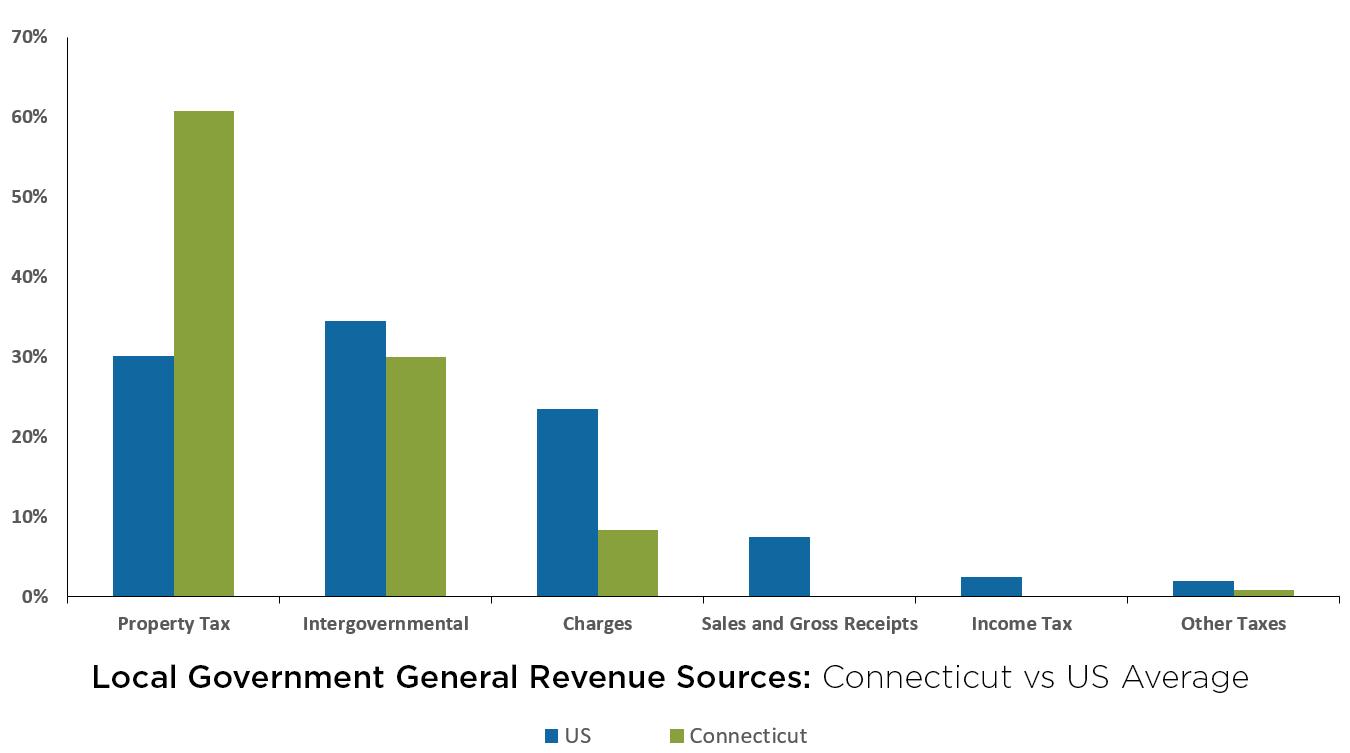




The property tax is the cornerstone of local government finance in Connecticut. Unlike many states, Connecticut imposes no statewide property tax. Instead, the 169 towns and cities serve as independent taxing authorities, responsible for assessing, levying, and collecting property taxes. As such, the property tax is not only the principal source of revenue for municipalities, but also the financial foundation for funding education, public safety, infrastructure, social services, libraries, and more.
The Connecticut property tax system is governed by state statutes along with local provisions at the municipal level. This has led to significant variation across towns in both tax burdens and revenue capacity. Connecticut’s dependency on property taxes, especially in the absence of robust alternative revenue streams, has been the subject of considerable scrutiny and reform discussions for decades.
Connecticut law requires towns to assess real and personal property at 70% of its fair market value. This
assessed value is then multiplied by the town’s mill rate, where one mill equals $1 of tax for every $1,000 of assessed value. Towns determine their mill rates annually during the budget process. As a result, the actual tax owed on a property reflects both the property’s assessed value and the town’s fiscal needs for that year.
For example, a home with a market value of $400,000 would be assessed at $280,000. If the town’s mill rate is 35, the annual tax would be $9,800. Mill rates vary widely between municipalities. Lower-income communities often have higher mill rates due to lower property values, leading to a regressive structure that raises equity concerns. According to the Office of Policy and Management, property taxes in some towns account for over 90% of all local revenue.
Property tax bills are generally sent out twice a year, with due dates in July and January. Interest accrues at 1.5% per month on delinquent taxes, creating compounding debt for struggling households and businesses.


The value of grand lists varies significantly across the state. This results in significant discrepancies between municipalities in their capacity to raise revenue.

In a number of towns, property tax revenue accounts for at least 80 percent to total revenue, with that number being 90 percent in a dozen towns. In more than half the municipalities in Connecticut, property tax revenue accounts for three-quarters of total revenue. Source: OPM Municipal Fiscal Indicators,
Each of Connecticut’s 169 municipalities maintains a Grand List: an official record of all taxable property as of October 1 each year. This list forms the foundation of the property tax system and reflects the total assessed value of real estate, personal property, and motor vehicles within a town’s borders. The Grand List determines the community’s tax base and directly informs the calculation of the mill rate needed to fund municipal services.
The mill rate is the tax rate applied to the assessed value of a property to calculate property taxes. It’s expressed as the amount of tax owed per $1,000 of a property’s assessed value.
There are three primary categories of taxable property in Connecticut:
• Real property: Land and buildings, including residential, commercial, and industrial structures
• Personal property: Tangible business assets such as machinery, equipment, and furnishings
• Motor vehicles: Assessed annually using standardized valuation guides (e.g., NADA)
All taxable property is assessed at 70% of fair market value, as required by state law. Local Assessor’s Offices are responsible for identifying and valuing each taxable asset using one or more of the following methods:
• Market approach: Based on recent sales of comparable properties
• Cost approach: Estimates replacement cost of structures minus depreciation
• Income approach: Applied to income-producing properties, based on projected revenue streams
Each municipality must conduct a revaluation of real property every five years, either through statistical modeling or full physical inspections. The purpose is to ensure that assessments remain current with local market conditions. Connecticut law (C.G.S. § 12-62c) allows towns to phase in assessment increases from a revaluation over up to five years, including the year it takes effect. Phase-ins can apply to all property or specific classes, and help prevent sudden tax increases for property owners. If revaluations are delayed, significant tax shifts may occur, especially in neighborhoods experiencing rapid appreciation, potentially leading to taxpayer dissatisfaction and appeals.
If a property owner believes their assessment is inaccurate or unfair, they may appeal to the Board of
Assessment Appeals, typically by March following the October 1 valuation date. Successful appeals may result in adjusted assessments and affect the town’s overall tax base.
Once finalized, the Grand List feeds directly into the municipal budget process, which usually begins in January or February. In most communities, department heads—including those from public works, police, education, fire, and social services—submit funding requests to the town’s Finance Director, Town Manager or Chief Elected Official. These are reviewed, consolidated into a proposed operating budget, and passed to the Board of Finance (or an equivalent body) for approval and public presentation. Local leaders will analyze the budget proposals and make decisions on programs and service that may need to adjusted.
To determine how much revenue must be raised through property taxes, town officials first estimate all non-tax revenues, such as state aid, fees, or federal grants. The remaining balance is the Net Property Tax Requirement—the portion that must be generated through the local tax base.
The mill rate is then calculated using the following formula:
Mill Rate = (Net Property Tax Requirement ÷ Net Grand List) × 1,000
Example:
If a town requires $60 million in tax revenue and its Net Grand List is $2 billion, the resulting mill rate is 30.
It’s important to note that a town’s mill rate is not just a product of its property values; it also reflects the scope of services the community expects or demands. For example, towns with larger school districts, fulltime public safety departments, or more extensive infrastructure may have higher tax requirements. In contrast, reducing service levels, such as limiting road maintenance or scaling back recreation programs, may reduce expenses and, possibly, the mill rate. The mill rate is ultimately a reflection of both the community’s ability to pay and the level of services it chooses to provide.

In addition to real and personal property, Connecticut towns tax motor vehicles annually as part of their Grand List. Vehicles are assessed based on a depreciated value schedule issued by the Office of Policy and Management (OPM), and then taxed using the local mill rate. However, due to longstanding concerns about disparities, the state implemented a motor vehicle mill rate cap, currently set at 32.46 mills (C.G.S. §4-66l).
This cap ensures that the same vehicle is not taxed dramatically differently across municipalities. For instance, a vehicle valued at $10,000 would owe no more than $324.60 in taxes, regardless of whether it’s garaged in a town with a 45-mill general rate.
To compensate towns whose standard mill rate exceeds the cap, as of 2025 the state provides a Motor Vehicle Property Tax Reimbursement Grant, funded through the Municipal Revenue Sharing Account (MRSA). The reimbursement is calculated based on the difference between the town’s regular rate and the capped rate, multiplied by the total value of eligible vehicles.
Example:
If a town’s regular mill rate is 40, and its vehicle list totals $100 million in assessed value, the town would collect only 32.46 mills. The remaining 7.54 mills would be reimbursed by the state, subject to available appropriations.
While this cap helps equalize vehicle taxation, towns with higher base rates rely on state reimbursements to maintain their budgets. Delays or underfunding in reimbursements create fiscal uncertainty.
Another factor affecting municipal budgeting is the Payment in Lieu of Taxes (PILOT) program. Certain proper-
ties, particularly those held by the state, private institutions, nonprofit hospitals, and federally exempt entities, are not subject to property tax, even if they benefit from municipal services. The PILOT program is intended to partially reimburse towns for this lost revenue.
There are two major categories:
• State-Owned Property PILOT (C.G.S. §12-19a)
• College & Hospital PILOT (C.G.S. §12-20a)
Under the tiered PILOT system, the state is supposed to reimburse a percentage of estimated tax losses by community wealth:
• Tier 1 (most distressed): 53% reimbursement
• Tier 2: 43%
• Tier 3 (wealthier): 33%
Payments are distributed each fall (by September 30). Although entitlement is formula-based, actual payments vary year-to-year and are subject to state budget appropriations. Unfortunately, as a result many towns receive only a portion of their statutory grant, potentially forcing residents to shoulder a larger share of municipal costs.
This gap between statutory expectations and actual funding can significantly impact urban municipalities like Hartford, New Haven, and Bridgeport, where tax-exempt properties make up a large portion of the real estate footprint. In response, recent reforms have implemented a tiered PILOT framework, increasing reimbursement percentages for fiscally distressed towns. Even so, many communities continue to highlight PILOT underfunding as a major budget challenge.
Final budget approval involves public hearings, workshops, and in some towns, referenda, ensuring transparency and community participation. Once adopted (typically by late spring) the mill rate is set, and tax bills are issued. Many towns have charter-defined deadlines requiring the budget to be finalized before July 1, the start of the new fiscal year.
The Tax Collector oversees the billing and enforcement process. Responsibilities include issuing tax bills, maintaining records, applying interest on delinquent balances (1.5% per month), and initiating collection actions such as liens or foreclosure proceedings if necessary.
To maintain professional standards, Connecticut administers a Certified Municipal Collector (CCMC) program. According to the 2020 CCMC guide, the
average tax collection rate across towns is about 98%, indicating both high compliance and effective local administration.
Connecticut offers a broad range of statutorily mandated and optionally authorized exemptions and abatements intended to support veterans, seniors, farms, businesses, and other priority groups. These provisions can significantly reduce taxable values and impact municipal tax bases.
1. Veterans Exemptions
Totally Disabled Veterans and their surviving spouses are fully exempt from tax on their principal residence, associated land, and one motor vehicle (§ 12-81(19)–(21), § 12-94). Honorably Discharged Veterans (non-disabled) are entitled to a flat exemption of $1,000–2,000 (§ 12-81(19)), with optional income-based enhancements under § 12-81g .
2. Disability and Blindness
Homeowners who are totally disabled or legally blind qualify for $1,000–3,000 in exemptions under § 12-81(18) and (23).
3. Elderly/Disabled Homeowner Credit
Individuals aged 65+ or totally disabled, earning below specified thresholds, can claim a credit up to $1,250 for married filers or $1,000 for singles (§ 12-170aa).
4. Military Vehicle Exemption
Active-duty military personnel, including non-residents stationed in-state, may exempt one vehicle annually with commanding officer certification (§ 12-81(20), § 12-94).
5. Tools, Equipment, and Environmental
Exemptions apply to mechanic’s tools, certain business inventory, farm equipment, and environmentally beneficial machinery (§ 12-81(60), § 12-81(68)).
6. Farm Machinery & Equipment
Exempt up to $250,000 in assessed value of farm machinery and equipment (§ 12-91, per PA 24-86).
7. Farmland & Open-Space Classification (PA-490)
Qualifying land may receive preferential tax assessment based on use-value; local authorities may offer

up to 50% abatement.
8. Industrial & Enterprise Zone Exemptions
New manufacturing machinery and eligible enterprise zone properties can receive up to five years of abatement, with 80% reductions in designated zones (§ 12-81(60), § 12-81(68)).
Municipalities may choose to provide additional exemptions (without state reimbursement) for purposes such as:
• Enhanced veteran or elderly benefits (income-based)
• Vehicle tax exemptions beyond state minimums
• Volunteer fire/rescue personnel
• Rehabilitation and historic preservation
• Nonprofit, cultural, and affordable housing property relief
These are governed by municipal ordinance and criteria vary widely.
• State reimbursement ensures that mandated exemptions, like those for veterans, elderly, disabled, blindness, and active-duty vehicles, do not reduce municipal revenues.
• Exemptions tied to business or farm incentives may receive partial or no reimbursement, depend-
Connecticut’s property tax system is central to how local governments fund services, but it also draws some frequent criticisms, especially around fairness and consistency. Below are a few of the most commonly raised concerns:
Towns and cities in Connecticut rely more on property taxes than in most other states. In many communities, property taxes make up over 80% of all local revenue. Since municipalities cannot levy their own sales or income taxes, this puts a lot of pressure on a single source of funding, which can be challenging during economic downturns or when property values decline.
There are wide differences in how much property wealth each town has. As a result, towns with higher-value properties can keep their tax rates lower while still collecting enough revenue. On the other hand, towns with lower property values often need to charge much higher tax rates to fund the same level of services. This leads to concerns that residents in less affluent communities may face higher relative tax burdens than those in wealthier areas.
Motor vehicle taxes are also a point of frustration for many residents. Even though there is now a statewide
cap on how high the tax rate can go, the amount owed on the same car can still vary from town to town. This variation is often viewed as confusing or unfair.
While property taxes are billed to property owners, the costs can trickle down to renters in the form of higher rent. Similarly, seniors and other residents living on fixed incomes may find it difficult to keep up with increasing tax bills, especially in towns where property assessments have gone up significantly.
• State Portal: CT Property Tax Services
• Pederson Real Estate Law: Understanding CT Property Tax
• Steadily: CT Property Tax Guide for Landlords
• Town of Tolland: Citizen’s Budget Guide (PDF)
• Glastonbury: How the Budget Works
• CCMC Tax Collector Manual: 2020 PDF
• State Portal: Real and Personal Property Tax Exemptions
• CAAO: Assessment Forms
The revenue options available to Connecticut towns and cities are limited by state statute. The property tax is the only tax over which municipalities have significant authority. Municipalities can levy a conveyance tax on real estate transactions, but that tax rate is set by the State and provides a relatively small amount of revenue.


Every day municipal o cials from CCM member towns and cities turn to the CCM Research Service to get the information they need. Any municipal o cial - whether you are a chief executive, local legislator, board or commission member, or departmenthead -can make unlimited research requests on any topic related to municipal governance or operations – included in your municipality’s CCM membership.
CCM is the state’s largest, nonpartisan organization of municipal leaders, representing towns and cities of all sizes from all corners of the state, with 166 member municipalities.
We’re just a click or a phone call away...
We come together for one common mission — to improve everyday life for every resident of Connecticut. We share best practices and objective research to help our local leaders govern wisely. We advocate at the state level for issues affecting local taxpayers. And we pool our buying power to negotiate more cost-effective services for our communities.
CCM provides prompt, accurate, customized responses to every member research request. The department uses an extensive collection of reference materials. From our in-house library to online databases and publications to our accumulated catalogue of research requests spanning close to 50 years of municipal governance in Connecticut, we have the resources at our fingertips that will save your municipality time and money. CCM is only a phone call or email away and is truly an extension of your o ce.
CCM is governed by a board of directors that is elected by the member municipalities. Our board represents municipalities of all sizes, leaders of different political parties, and towns/cities across the state. Our board members also serve on a variety of committees that participate in the development of CCM policy and programs.
We’ll find out for you how other municipalities improve local services and solve di cult problems. Whatever information you need, our research and information service provides the practical materials you need to do your job e ectively. Sample inquiry topics include:
•Budgets • Charter Provisions • Economic Development • Environment • Federal Laws
•Financial Statistics • Housing • Job Descriptions • Municipal Finance • Ordinances
Federal representation is provided by CCM in conjunction with the National League of Cities. CCM was founded in 1966.
•Organization Charts • Personnel Policies


webcontact@ccm-ct.org
ccm-ct.org/Advocacy/Research
545 Long Wharf Dr., New Haven, CT 06511